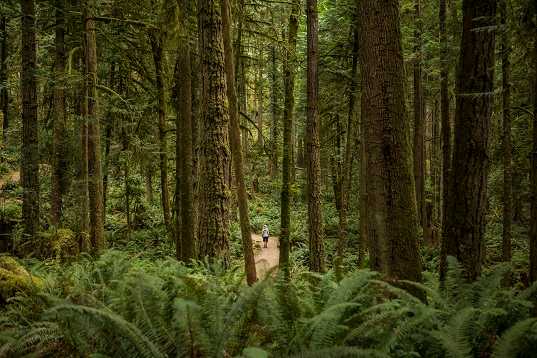A lot has changed since the CIA was founded in 1947. Sweeping advancements in technology, a new and evolving threat landscape, and the nuances of an increasingly globalized world mean that the CIA of today looks remarkably different from the CIA of yesteryear. CIA’s headquarters in Langley, Virginia, was built in 1952, predating the Internet, the personal computer, and yes, even the microwave oven. And while the CIA has evolved tremendously over the years, there are certain elements of our mission that are, for lack of a better word, timeless.
In 1951, CIA instructors developed “Introduction to Survival,” a course meant to prepare Agency officers with the skills needed not only to survive—but thrive—in wilderness conditions. Documents declassified in August of 2000 include a nearly 300-page course manual that guided students through the core principles of wilderness survival, including parachute jumping, ground navigation, hunting and stalking techniques, fire building, personal hygiene, first aid and much, much more.

“It cannot be too strongly impressed on all personnel,” the manual says, “that what they are learning in this course is for their own personal benefit and to provide them with as much knowledge as possible so that if they are ever forced down in uninhabited regions, they will be able to exist until help arrives.” The course acts as a self-described “personal insurance policy” that officers should avail themselves of; if only to be prepared should the worst happen.
You may not have the time to peruse this 300-page document, so we’ve done the leg work for you. After combing through every page of the 1951 “Introduction to Survival” manual, here are our key takeaways, should you ever be stuck in the wild, “three hundred miles from the nearest habitation with nothing except what is on your back.” Be aware that these key takeaways generally revolve around the ‘soft’ skills of wilderness survival. Those interested in the ‘hard’ skills should explore the original document in its entirety, where there are very useful tips on building shelters, hunting, fishing, land navigation and all manners of wilderness survival skills.
Be Patient
“A novice will view the landscape from the top of a hill with what he considers is care and interest and then say, ‘let’s go.’ The experienced man will clean his binoculars, settle down comfortable and start surveying the surrounding countryside carefully.”

Patience truly is a virtue, one that will pay dividends – as it turns out – in wilderness survival situations. This seems to be a reoccurring theme throughout the survival manual, where instructors tout methodical movement and intentional action as key to a successful outcome. From choosing the most favorable route to civilization, to stalking game and fishing, to constructing a dependable raft, diligent and meticulous planning will define the true survivalist.
Be Observant
“Careful and intelligent observation will train you to interpret correctly the things you see, whether they are distant landmarks or a broken twig at your feet.”
The development of acute observational skills is essential to the toolkit of every survivalist, according to the manual. Land navigation, wild game hunting, and campsite selection can all be improved with intelligent observation. Observational skills can be especially important, in the case of the CIA officers for which this training was intended, if traveling in hostile territory. “Where populations are unfriendly,” the manual notes, “it will be necessary to travel at night.”
Don’t be a Jerk
“Some men who are forced to live under crowded conditions, such as that to be experienced in snow houses become irritable and ‘get on each other’s nerves.’ The feeling of animosity among two or more men can destroy the efficiency of a whole part to a greater degree than illness of physical injury.”
It may seem an obvious one, but when forced into a trying situation and treacherous conditions, maintaining your reputation as an agreeable travel companion may not rank very high on the priority list. Not sure exactly how to stay on good terms with your compadres? Luckily, the survival manual has given us a concise, but foolproof list of ‘do nots’:
- Uncleanliness while handling food
- Dirty or ill-smelling clothing
- Occupying more than a rightful amount of space in the shelter
- Slackness on the job so that others are forced to do more than their share
- Eating more than the right share of an allowed food ration
- Constant complaining
So, in short, don’t be a jerk. It could save your life.
Practice Your Skills
“Trail-walking practices develop progressively and instinctively with time, and a clear mind will register observations and form deductions almost subconsciously.”
This course, as we mentioned earlier, was described to students as a ‘personal insurance policy’ against death in a wilderness survival situation. Just like a car insurance policy, if you don’t “pay” your policy— or in this case, practice the skills you need—you can’t expect coverage in the event of an accident. In nearly every section of the course, the instructors implore students to practice the skills learned. By practicing land navigation, shelter building and fire building, we can commit the skill to muscle-memory so that when they are called-upon in a real-life situation we are prepared to survive.
Take Care of Your Gear
“In survival you are on your own as far as your clothing is concerned. There is no re-supply and what you have must last you until the emergency is over. Learn now how to wear properly and care for your clothing.”

The proper cleaning, protection and general maintenance of clothing and gear are among the top concerns of the adept wilderness survivalist. It is a theme routinely discussed throughout this manual, whether the instructor is discussing clothing care and maintenance, proper cleaning and protection of weapons, methods to clean and sanitize cooking and eating utensils or proper packing to ensure your gear remains dry. When traveling in the wilderness with limited resources at your disposal, it is important to care for all of your gear so that it can properly care for you.
Stay Clean
“Most of us have a tendency, when relieved of civilized environment and the social requirements of civilization, to relax and show complete disregard in our daily cleanliness habits.”
It’s easy, in an emergency situation, to preoccupy our thoughts with an escape plan. So easy, in fact, that we might lose sight of those things which are essential to survival, paramount among them being cleanliness. Personal hygiene, campsite and clothing cleanliness are all important to sustained survival in the wilderness. Any number of infections and diseases can spread through unwashed clothing, skin or cooking utensils. So, if possible, prioritize a regular personal hygiene routine.
Stay Calm
“More important than any specific thing I can tell you to do, or not to do in a certain situation, is to emphasize the necessity of your remaining calm and using your common sense. If each of you do this, you will properly evaluate each condition with the environment and situation present and know better what to do at the time than I could possibly hope to inform you.”

This key takeaway needs no explanation: The calm person is least likely to make a hasty decision. They are the least likely to bite off more than they can chew. Their approach is more likely to be thoughtful, rational and methodical, and is the most likely to yield a positive result. It is sometimes difficult to maintain composure when the odds are stacked against you, but doing so is sure to pay off in the long term.
Preparedness has always—and continues to be—a core element of the intelligence officer’s toolkit. Our analysts prepare briefings for policymakers that anticipate the many possible outcomes from a given scenario. Operations officers, when meeting with sources, take great care in developing primary, secondary and even tertiary plans to adequately defend the secrecy of their meetings. As intelligence officers, we are trained to think of every possible eventuality, and to prepare a thoughtful and considered response. That fact was as true in 1951 as it is today.
If preparation and adventure appeal to you, consider learning more about careers with CIA.
